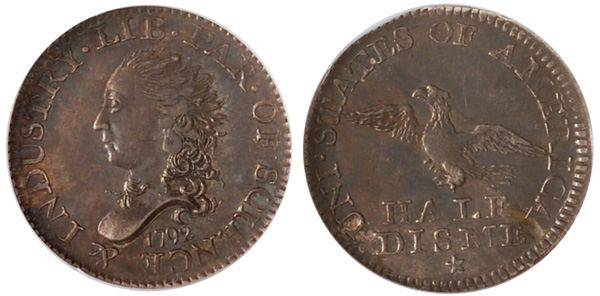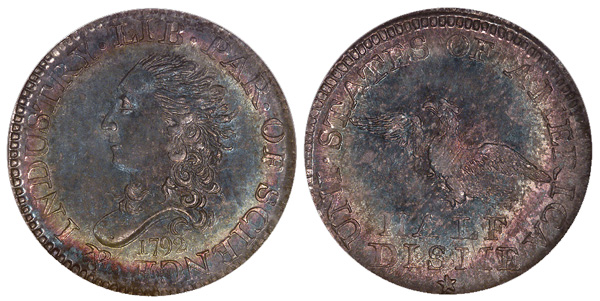Background and History
The 1792 Half Disme (Buy on eBay) (pronounced “deem,” which later evolved into the modern pronunciation of dime) has the honor of being the very first coin struck by the United States government. While coins had been produced on American soil since the mid-17th century and even after the colonies declared independence, no coins had been officially struck and released by the newly formed country. The limited number of half dismes and various pattern denominations struck in 1792 would represent the official start of coin production by the United States Mint.

The Coinage Act of 1792, which was signed into law on April 2, 1792, would set the stage for the United States monetary system as well as coinage production. This act designated the dollar as the standard unit of money, established the United States Mint, and authorized the production of denominations ranging from the half cent to ten dollar gold piece. The act also authorized the Mint to construct its first building. The cornerstone was laid in Philadelphia on July 31 of the same year, representing the first federal building raised under the Constitution.
The half disme, with a value of five cents, was the only denomination struck in a reasonable number in the year the Coinage Act was signed into law. Other denominations, such as the disme (ten cents), were only produced in extremely limited numbers and are considered to be patterns. Production of copper coinage, comprising half cents and cents, would not commence until the following year. The other silver denominations were not introduced until 1794, while gold coins were first struck at the Philadelphia Mint in 1795.
The design of the 1792 Half Disme is believed to have originated from the so-called Birch cent, one of the pattern issues of 1792. According to the Judd reference on United States patterns, the name Birch could refer to either William Birch or Robert Birch, both citizens of Philadelphia at the time. The obverse of the coin features a head of Liberty, while the reverse shows an eagle in flight with a much different appearance compared to later versions used on United States coinage. The most prominent lettering is on the obverse, indicating “LIB. PAR. OF SCIENCE & INDUSTRY” (Liberty Parent of Science and Industry), which appears to have originated from Benjamin Franklin.
Key Date Coin Mintage
Although it has been traditionally listed in pattern references, most consider the 1792 Half Disme to be represent the first regular issue coin struck under the Coinage Act of 1792. There are some numismatic researchers who still consider the coins to be patterns, however the facts and circumstances as well as statements made by George Washington indicate that this was intended to be a regular issue.
First of all, the mintage of the issue is believed to have been around 1,500 to 2,000 pieces, which would have been extremely high for a pattern during this time period. While one of the most famous pattern issues (the 1856 Flying Eagle Cent) had a similarly high mintage, the late 18th century was a much different time and the interests were different as well. Furthermore, many of the 1856 Flying Eagle Cents are believed to have been restrikes, while no restrikes are believed to have been made of the 1792 Half Dismes.
Another point that can be made in favor of the “circulation-issue” standpoint is that a relatively high number of survivors (approximately 10% of the mintage) is found in well circulated grades such as Good or Fine. If they had only been given out as presentation pieces, it seems unlikely that these coins would have experienced significant circulation. The most conclusive fact, however, is a statement made by President George Washington in an address to Congress in November of 1792: “There has been a small beginning in the coinage of half dimes, the want of a small coin in circulation calling the first attention to them.”
There are two stories commonly linked to the 1792 Half Dismes, which have become part of the numismatic folklore. First of all, it is said that the silver that was used to strike the 1792 Half Dismes was personally provided by George Washington. According to the legend, he had supplied part of his own tableware to start the coinage in the basement of a Philadelphia saw maker. Some researchers have disputed the story and contend that the U.S. Government had supplied the silver in the form of bullion. Secondly, it has been suggested that Martha Washington may have provided inspiration for the image of Lady Liberty on the obverse of the coin. When comparing the few contemporary images of her with the design of the 1792 Half Disme, this assertion seems to be more myth than reality since the images do not share many similarities.
Finest Known and Values
From the small original mintage of 1792 Half Dismes, it has been estimated that between 250 and 400 pieces have survived. Judging by the number of auction appearances of this historic issue, the latter seems a bit high and the true number probably lies closer to the former. Among the surviving examples, a relatively high number of uncirculated specimens are known to exist.

The finest known example of the coin has been graded MS-68. This coin previously resided within an NGC holder carrying this grade and was sold in a private treaty transaction for $1,500,000 in 2007. The coin was subsequently crossed into a PCGS holder at the same grade of MS-68 and sold to an anonymous collector for $1,985,000 in 2018. Besides representing the highest numerically graded example, this coin carries historical significance as it was formerly owned by the first United States Mint Director David Rittenhouse.
Another superlative example of the coin has been designated as a specimen strike and graded PCGS SP-67. Its status as a specimen striking is disputed, and it does not appear to be the first coin struck from the dies, as some sources claim. This is attested by the fact that some faint die cracks are visible on the reverse of this coin, which are not present on some other examples preserved in lower grades. However, the coin is very special, with a needle-sharp strike and proof-like surfaces. The coin crossed the auction block twice in the past few decades, selling for $1,322,500 in 2006 and $1,410,000 in 2013.
The population reports show an additional MS-67 coin graded by PCGS, followed by three coins graded MS-66. One of the PCGS MS-66 pieces sold for $493,500 at auction in 2017. The NGC census shows two pieces graded MS-65, as the finest currently encapsulated by the service.
Uncirculated and About Uncirculated 1792 Half Dismes easily sell for six figure sums, while circulated and damaged pieces command lower prices. Barely recognizable and heavily impaired examples can be found for less than $10,000, but due to the historic status of this issue, even these pieces are in high demand.

